Add this eBook to your basket to receive access to all 72 records. Our indexes include entries for the spelling sammons. In the period you have requested, we have the following 72 records (displaying 51 to 60): These sample scans are from the original record. You will get scans of the full pages or articles where the surname you searched for has been found. Your web browser may prevent the sample windows from opening; in this case please change your browser settings to allow pop-up windows from this site. Soldiers wounded: South African Infantry
(1916)
Lists of names of soldiers wounded, died of wounds, died, missing presumed dead, and taken prisoner by the enemy, were issued to the British national press under the title Roll of Honour. Each man is identified by surname, initials and number. The regimental returns from which the daily Roll was compiled were made up over the previous week or weeks. Each regimental return may be partial, covering only part of the alphabet. The lists are provisional, in that a man reported wounded one day may appear as died of wounds later; a missing presumed dead may later be reported as having been found, or as having died; the lists of prisoners of war were provided by the enemy and will relate to captures weeks earlier. However, these rolls are the most comprehensive single source of names of British and allied combatants meeting with misfortune in the Great War. This is the roll published 2 August 1916. | Sample scan, click to enlarge
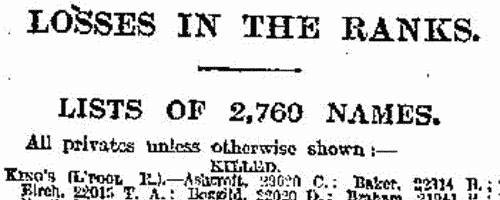
| Soldiers of the Birmingham City Battalions who fought in the Great War
(1919)
The Roll of Honour for the 14th, 15th and 16th battalions of the Royal Warwickshire Regiment has complete lists of men, with roll number, rank, surname and initials, for each platoon, each platoon list having a matching group photograph. | Sample scan, click to enlarge

| Workers from the City of Birmingham Electric Supply Department who fought in the Great War
(1919)
The Roll of Honour for the department lists the men who joined his Majesty's forces, giving for each his surname, initials, and regiment. The names of those killed in the conflict are marked with asterisks; those who died with a dagger; those missing with a double dagger. | Sample scan, click to enlarge
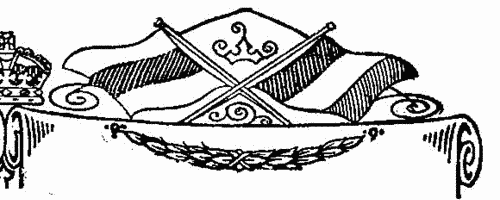
| Navy deserters
(1923)
The Police Gazette was published by Authority by the London Metropolitan Police, and circulated, as confidential, to the police forces throughout Britain and Ireland. The contents were based on the information routinely submitted to the Criminal Record Office. One of the regular features was a list of deserters from the Royal Navy. This gave, for each sailor: Office Number (i. e., number in the deserters' list); Name (surname and initial(s)); Ship Deserted From (and whether straggler or deserter); Date; Rating; Where Born; Age; Height; Complexion; Hair Colour; Eye Colour; and any Distinguishing Marks (usually scars or tattoos) and Remarks. | Sample scan, click to enlarge

| Medical Practitioners in the Provinces
(1926)
The Medical Directory was split into several sections. The Provinces section covered all medical practitioners resident in England outside the London postal district (except those in Monmouthsire, who were listed under Wales). Each year a schedule was sent to each doctor to be returned to the publishers, so as to keep the directory up to date. In the directory the doctor's name is given first, in bold, surname first, in capitals; then current address. Next are the qualifications; the italic abbreviations in parentheses following the qualifications indicate the medical school at which they were gained. Then there is a list of posts and honours within the profession, starting with those then current; previous posts are preceded by the word 'late'. Finally, brief details are given of any publications. | Sample scan, click to enlarge

| British Civil Servants
(1935)
The British Imperial Calendar lists civil servants in Britain, arranged according to the organizational structure of the state, and shows their qualifications and salaries. | Sample scan, click to enlarge
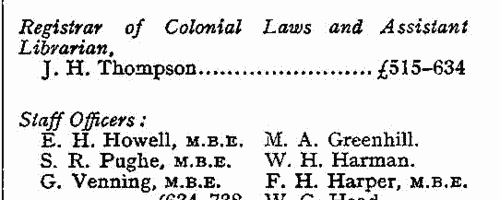
| Boys entering Trinity College, Glenalmond
(1937)
Trinity College, Glenalmond, Perthshire, was originally founded as a college at which young men might be trained for the ministry of the Scottish Episcopal Church, and the sons of the laity might be educated and brought up in the faith and tradition of the Church. In 1876 the Theological College was transferred to Edinburgh, Glenalmond remaining as a boys' school. This second edition of the school register, edited by G. St Quintin, was published in 1955, incorporating the text of the first edition prepared by E. W. Neish. The scholars are listed by term of entering the school, and then alphabetically by surname; the details then given are full christian names, date of birth; name of father; any distinctions within the school; and then a career synopsis, with date and place of death where known. | Sample scan, click to enlarge
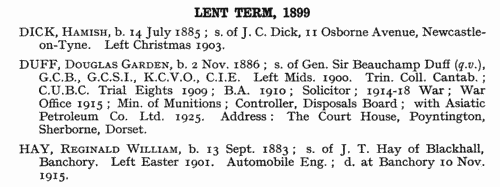
| Inhabitants of Blackheath, Lee, Greenwich, Eltham and Mottingham
(1937)
Kelly's Directory of Blackheath, Lee, Greenwich, Eltham &c. includes this directory of private residents, listed alphabetically by surname and christian name, with address, covering an area extending from the river Thames on the north to Mottingham and Grove Park on the south, and from Eltham on the east to Deptford Creek and Hither Green on the west. These abbreviations are used in the addresses: B, Blackheath; D, Deptford; E G, East Greenwich; G, Greenwich; L, Lee; and Lew, Lewisham. | Sample scan, click to enlarge
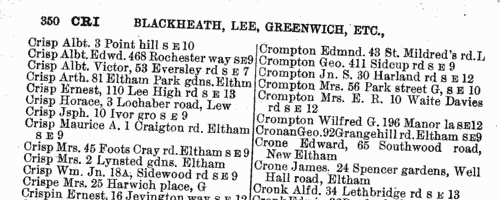
| London Telephone Subscribers
(1939)
The London telephone directory lists subscribers alphabetically by surname and then by christian name or initials, with their postal address and telephone number. This is the L to Z directory issued in May 1939, but also contains some names from earlier in the alphabet, for instance in the separate section for midwives. The London telephone districts comprised not only the city centre, but also the very extensive suburbs in the Home Counties (Essex, Kent, Surrey and Middlesex). | Sample scan, click to enlarge

| Naval Officers
(1939)
The alphabetical list of officers on the Active List of the Royal Navy and Royal Marines (RM) gives: where serving; name (surname and initials); rank; and the dates of their seniority. This is the list from the March 1939 edition of the Navy List, corrected to 18 February 1939. | Sample scan, click to enlarge

|
Research your ancestry, family history, genealogy and one-name study by direct access to original records and archives indexed by surname.
|











